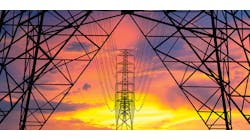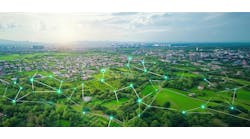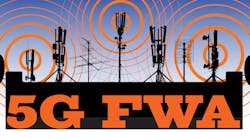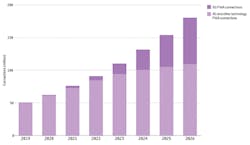Latest from 5G/6G & Fixed Wireless Access/Mobile Evolution
While we see many 5G ads targeting consumers, there are a plethora of non-consumer applications and solutions (aka Use Cases) unique to 5G because of its high data rates. Some 5G systems can reach 10 gigabits per second — that is up to 100 times faster than 4G as well as having a reduced latency.
As the future of industrial manufacturing begins to take shape, we’ll see 5G supporting smart factories and the Industrial Internet of Things (IIoT). 5G, with its high data rates and low latency, allows for the design of manufacturing and production plants and intralogistics to be more flexible, autonomous, and efficient.
There are different flavors of 5G. Each is well suited for its application:
- Lower-band 5G provides a blanket layer for wide coverage, sometimes referred to as the coverage layer. Low-band refers to frequencies below 1 GHz used to roll out substantial 5G coverage as quickly as possible. One example is the 600 MHz spectrum that is deployed by a major cellular service provider for nationwide coverage. A low-band cell site can cover hundreds of square miles as well as deliver a downlink data rate from 30-75 Mbps download. These low-band signals can pass through buildings to provide coverage both indoors and outdoors.
- Mid-band 5G is suited to provide solutions in major metropolitan areas. Mid-band 5G uses mid-range frequencies (spanning 1 GHz and 6 GHz) that strike a balance between coverage and capacity, with operators currently deploying 2.5 GHz in the US. This is sometimes referred to as Sub-6 or Sub-6 GHz 5G that refers to 5G deployments using spectrum under 6 GHz. These bands are being harmonized globally, which can provide benefits for international roaming. Mid-band 5G base stations can transmit and receive high-capacity signals that provide service over a fairly large service area, and provide download speeds around 115-223 Mbps.
- High-band or millimeter Wave (mmWave) 5G is also well suited to provide high-speed connectivity in major metropolitan areas. 5G mmWave refers to higher-frequency radio bands ranging from 24GHz to 40GHz and is also referred to as 5G plus and 5G Ultra-Wideband. Though it is ultra-fast, 5G mmWave doesn’t carry very far — only about 1,000 to 1,200 feet, and even less than 300 feet for the higher frequencies. 5G mmWave provides innovative solutions for outside plant and inside building deployments because, in addition to providing high-speed connectivity in metropolitan areas, it is an excellent option to replace many fixed wireless applications such as cable or fiber drops to fixed user locations.
With its massive capacity, in particular achieving gigabit speeds, 5G mmWave is a robust and crucial solution to meet the increasing traffic demand. The solution also expands broadband services to help bridge The Digital Divide throughout rural, suburban, and urban, communities. 5G mmWave can have peak speeds of nearly 1 Gbps, and upload speeds near 50 Mbps, with the potential to offer data rates of up to 10 Gbps.
5G FWA To Consumers
Those same ads sharing the miracles of 5G for consumers may not specify that FWA is the tool being used. In fact, FWA connections are forecast to grow more than threefold and to reach over 180 million by the end of 2026. This could account for around 25% of total mobile network data traffic globally. (See Figure 1.) (Source: www.ericsson.com/en/fixed-wireless-access)
Fixed Wireless Access (FWA) delivers capacity, availability, and throughput quality of service (QoS) by complementing fixed alternatives such as fiber, cable, or xDSL. Technically it is already feasible today to offer high enough data throughput rates to match fixed broadband alternatives.
5G FWA helps serve Last Mile connectivity challenges to consumers by allowing operators and original equipment manufacturers (OEMs) to deploy 5G in homes, schools, libraries, and hospitals.
- It provides the bandwidth required to support high-definition video streaming that can improve remote education and healthcare experiences in suburban and rural environments.
- It’s expected to enable robust services with sustainable rates that are high enough to meet the foreseeable needs for home use well into the future.
- It is also poised to offer peak cell rates that few fixed technologies, including fiber, will be able to.
With 5G FWA, every household and business can have the ability to connect to reliable Internet access no matter where they are located because it can deliver high bandwidth to customers in areas where Fiber-to-the-Home is not feasible or cost-effective.
From a local site such as a utility pole, a FWA network connection is achieved without wires. Instead, a "fixed" antenna, about the size of a small smoke alarm, is installed outside the house. (Consider it similar to how a satellite dish might be installed.) This antenna then creates a wireless connection with a nearby antenna installed on existing cell towers, utility poles, buildings, and similar locations.
A single network location can serve many home antennas simultaneously. Therefore, 5G fixed wireless greatly decreases the physical infrastructure needed to provide reliable Internet, and uses less energy to connect and transmit data as compared to some wireline and fiber connections.
High-speed connectivity is achieved without the need to run aerial drops or trench between the network equipment and the served premises. The Last Mile is bridged via a short-distance, wireless connection. And when it comes to FWA, it doesn’t require right-of-way if compared to fiber. Nor does it require digging, which is very expensive.
When the fixed antenna receives the signal, it can send the connection down a short run power over an Ethernet CAT5 or CAT6 cable and into the building or house. Once inside, the cable can physically connect to a router and other devices as needed.
Another key differentiator is that a home antenna and devices can be installed by the homeowner or business owner. This greatly speeds deployment and saves money. Figure 2 shows a typical FWA deployment showing Ericsson Radio RRU and RBU radios and customer premises equipment (CPE).
Currently, work is underway to improve the 5G FWA radius by utilizing different radio spectrums that allow for longer distances. Initiatives are also at work for local authorities to help set up small cell infrastructure with tiny nodes that can be placed in convenient locations.
Fixed Wireless Initiatives Fall Into 3 Different Segments
Fixed wireless initiatives fall into 3 different segments with different characteristics defined by the offering and availability of fixed access.
1. Connect the unconnected— It is characterized by virtually non-existent fixed broadband alternatives along with the reality that the most dominant way of accessing the Internet in these areas is via mobile broadband using smartphones. ARPU levels are moderate and user expectations for access speeds are relatively low. Typical sold data rates are 10-100 Mbps.
2. Build with precision — In this segment there might be some availability of xDSL. However, there is a limited business case to provide fixed broadband alternatives. This segment has great demands for high data rates and capacity. Typical sold data rates are 50-200 Mbps.
3. Wireless fiber — This segment competes with fixed broadband because there is demand for higher rate offerings and capacity. The ambition is to provide fiber-like speeds and to handle
the household’s TV needs. Typical sold data rates are 100-1,000+ Mbps.
When looking at 5G, the 3 Cs are important: Does the network have the Capacity to handle network loads? Are the systems Compact enough to deliver performance when you are tight on space? And does it provide Coverage to connect customers, wherever they are? (See Figure 3.)
5G FWA helps cover the 3 Cs of wireless services. Complementing fiber by replacing xDSL lines, as well as other aging and legacy infrastructure, FWA can help connect homes and business for the next generation of high-speed data access.
For more information, please email [email protected] or visit https://www.ericsson.com/en. Follow Ericsson on Twitter @ericsson. Additional Company Social Media Handles: @ericsson.
Like this Article?
Subscribe to ISE magazine and start receiving your FREE monthly copy today!

Ernie Gallo | Director at Network Infrastructure Solutions, a division of Ericsson, Inc.,
Ernie Gallo is Director at Network Infrastructure Solutions, a division of Ericsson, Inc., and an IEEE C2 National Electrical Safety Code - Committee Member, Subcommittees SC2, SC4, SC5, and SC8. He has more than 40 years of experience in outside plant products, requirements, deployment, and electrical safety codes and standards such as the NEC and NESC. For more information, please email [email protected] or visit https://www.ericsson.com/en. Follow Ericsson on Twitter @ericsson.
For more information, please visit https://standards.ieee.org/products-programs/nesc/ to learn more information about the NESC and NESC Products. Follow the IEEE SA on Twitter @IEEESA. We welcome you to contribute to our efforts by joining the NESC.







